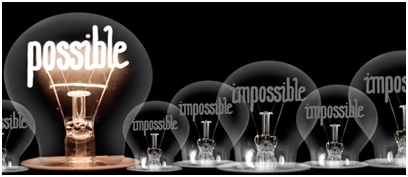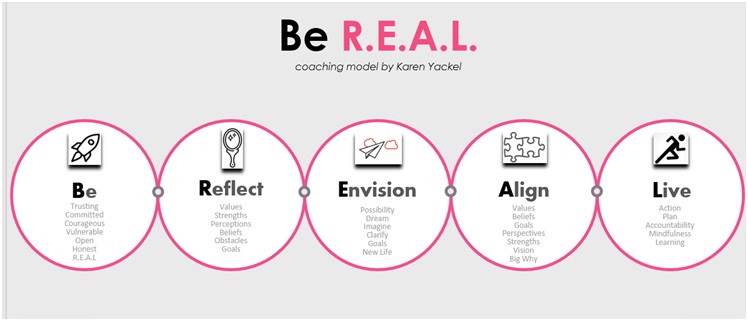A Coaching Model Created by Karen Yackel
(Life Coach, CANADA)
The Be R.E.A.L. coaching model has been put together by combining my years of experience as an educator, my own values and beliefs, and the REAL challenges of my clients. This model needed to Reflect who I am as a person and coach and what I Envision as a tool for my clients. It also needed to be in direct Alignment with who I see in the mirror and who I want clients to see in the mirror. I know that when clients see who they really are and what they really want they can fly and go Live fuller and richer lives.
I came to coaching believing that my many years as an educator provided me with a unique set of skills to offer my clients. The following are just a few of what I feel I bring to coaching and to this model:
To combine these educator skills with coaching skills for this model and for my practice I decided to start at the beginning of my own journey. In fact, the whole premise of Woman in Mirror Coaching is to take a good look in the mirror and evaluate what you see in all areas of your life. I did this many years ago when I found myself in a rather dark place. I did not like what I saw on many levels, not just based on appearance, but my whole self. This started me on my personal journey to finding myself again and tearing down the things I didn’t like and to work on building myself back up until I was proud of the reflection I saw in the mirror. The more I grew I understood that this was not an issue for just me but for many other women, teens, and young adults and so, my practice and this model were born.
Take the first step in faith. You don’t have to see the whole staircase, just take the first step. Martin Luther King Jr.
Begin
 The first step can often be the hardest step. As a Coach, I know that for clients to even understand that they may need a Coach to help them with their new beginning is difficult. When they take that first step to reach out to a Coach, which for many takes a great deal of courage, they know that they will need to put their trust in the process. In reaching out they are making a commitment to connecting with a coach, to be vulnerable, take a leap of faith in themselves, and to be open to other possibilities. They may also realize that they will need to push themselves out of what I call their “comfort box” in order for real change to happen they will need to be able to just Be in their own space. The understanding that happens in this step is that it is important to Be REAL, and honest both with themselves and the Coach.
The first step can often be the hardest step. As a Coach, I know that for clients to even understand that they may need a Coach to help them with their new beginning is difficult. When they take that first step to reach out to a Coach, which for many takes a great deal of courage, they know that they will need to put their trust in the process. In reaching out they are making a commitment to connecting with a coach, to be vulnerable, take a leap of faith in themselves, and to be open to other possibilities. They may also realize that they will need to push themselves out of what I call their “comfort box” in order for real change to happen they will need to be able to just Be in their own space. The understanding that happens in this step is that it is important to Be REAL, and honest both with themselves and the Coach.
To Be in a trusting space with a Coach to unwrap their layers and just sit in that space and Be R.E.A.L.In this step the client understands that in order to Be REAL they need to:
When a client is willing to take the steps above, it is clear that they are open to discovering new knowledge about themselves. They are ready to take on the challenge of Designing their Path. When it is clear to coach and client that these are the steps that need to be taken then coaching can Begin. I say this because, for me, this is my ideal client, someone who is ready, to be honest, ready to work, ready to make their life more meaningful. Establishing the client’s trust through the Coach’s curiosity without judgment or agenda will help the client to feel safe enough to Be REAL with themselves in order to take on the next step which is to Reflect deeply and begin to move forward toward their goals.
Self-reflection entails asking yourself questions about your values, assessing your strengths and failures, thinking about your perceptions and interactions with others, and imagining where you want to take your life in the future. Robert L. Rosen
Reflect
 I don’t think I could have summed up how I feel about coaching, my model, and self-reflection better than the quote above. It seems to speak to my essence as a Coach and to what I believe is needed for change. What does the client see in the mirror? What strengths do they see? What weaknesses to they want to improve. These are the first questions I ask a client when they come to the coaching process.
I don’t think I could have summed up how I feel about coaching, my model, and self-reflection better than the quote above. It seems to speak to my essence as a Coach and to what I believe is needed for change. What does the client see in the mirror? What strengths do they see? What weaknesses to they want to improve. These are the first questions I ask a client when they come to the coaching process.
Next, we discuss what goals they have in mind for themselves? What are their values, their perceptions, and their limiting beliefs?
In this step, clients are invited to take a good look in the mirror and to discuss, list, draw, or visualize what they see. Once they have identified what is good in their Reflection and what needs to change in their mirror image in all areas of their life, we next Reflect on their values. What are their core values? And is their life progressing in line with their values?
This step can be a lengthy process as a lot of difficult and wonderful discoveries can be made here. With deep Reflection through means of powerful questioning and other tools such as meditation, journaling, and mindfulness, the client continues to gain the awareness needed for further exploration. This is really a place where the lightbulbs start to flicker. For the client to unwrap themselves and start to see more clearly the obstacles in front of them, and the strengths they possess, they can begin to see the patterns, the limiting beliefs, and perceptions.
Defining their Core Values is a really important part of this step. For the client to Reflect on what they truly value and why and how it is or isn’t showing up in their life can be such a huge learning experience. This kind of Reflection is a big catalyst for change and change is what the client is looking for.
Clients in this step of the model Reflect on:
This is also a place to move the client’s awareness to the tools they already possess. Once this has been awakened in the client they can go to the next step – Envision.
The act of envisioning is mainly useful as a means for identifying what matters most to you now. Stewart D. Friedman
Envision
 Next is the time for the client to get clear on what it is they really want and to Envision the possibilities. This clarity may not always be easy because clients often come to coaching looking for clarity. But, if the client has done the work in the Be and Reflectparts of the model this step should become somewhat easier.
Next is the time for the client to get clear on what it is they really want and to Envision the possibilities. This clarity may not always be easy because clients often come to coaching looking for clarity. But, if the client has done the work in the Be and Reflectparts of the model this step should become somewhat easier.
Many clients have a difficult time with this part of the model. This is where many fears can rear their ugly heads. Fear of dreaming big, failure, success, and so many other fears. But in taking the chance and again getting out of their “comfort box” clients can really open themselves up to possibilities. They may need to go back and revisit Reflect in this step to draw on what they have learned about themselves to become clearer in this step.
In many articles and books that I have read over the years, one thing that has always stood out to me has been to be CLEAR on what you REALLY WANT. Over and over again these words came up for me during my own battle with Envisioning my life and what I wanted the future to look like. I believe it is important to take the client through several steps to help them clearly Envision what they want in the areas of their life they are seeking help with: relationships, goal setting, positive habits, balance, career, family, etc.
There are many tools that the Coach can use to help the client Envision their new way of being. Below are a few examples:
As clients Envision what they want they take the Reflections they have made and stick them into their goals and dreams and begin to Envision a new reality and become more open to possibility. This to me is an exciting stage and one that I think isn’t always delved into as it should be because this is the stage is where the client can dream without the worry about how they are going to get there. Just dream, imagine change and Envision the possibilities. Now that the client has a clearer vision of their values, goals, and dreams they are ready to Alignthese together to take another step forward in Designing their Path.
Just as your car runs more smoothly and requires less energy to go faster and farther when the wheels are in perfect alignment, you perform better when your thoughts, feelings, emotions, goals, and values are in balance. Brian Tracy
Align
 This step, in my opinion, is really the most important. It involves taking all the learning so far and Alignit with values and beliefs. There may be a need here to revisit the Envisioning process during this stage as important discoveries through deep exploration may uncover misalignment with core values and underlying beliefs, obstacles, self-sabotage, and more.
This step, in my opinion, is really the most important. It involves taking all the learning so far and Alignit with values and beliefs. There may be a need here to revisit the Envisioning process during this stage as important discoveries through deep exploration may uncover misalignment with core values and underlying beliefs, obstacles, self-sabotage, and more.
The alignment stage is extremely important for the client. They must take time here to really dig deep, understand, and accept themselves along with their new-found strengths and tools in order to achieve the success they desire. Acceptance is imperative to Alignment here because even though we have uncovered many things in the previous step we haven’t taken all the information to a place where we can blend them together. There may be resistance on the part of the client as this is really where the hard work it. It is the beginning of their action plan.
In this step the client will align:
As you can see there are some parallels with the other steps, but in this stage when the client’s core values are aligned with their goals, their big Why, their vision, and their reflections, then they are finally ready for the next step – LIVE.
Go confidently in the direction of your dreams. Live the life you’ve imagined. Henry David Thoreau
Live
 The last stage is to take all the knowledge and learning gathered and put a plan in place for the client to LIVE and take action with a reflection in the mirror that they are proud of. In this stage the coach focusses on Mindfulness, Creating Action, adding Structure to the goals, and putting the client’s Intent into a doable plan. Again, the client may need to revisit any of the stages to make sure they have all the tools needed to move forward. The client is now designing their path forward with purpose so they are motivated to embrace all that has been discovered.
The last stage is to take all the knowledge and learning gathered and put a plan in place for the client to LIVE and take action with a reflection in the mirror that they are proud of. In this stage the coach focusses on Mindfulness, Creating Action, adding Structure to the goals, and putting the client’s Intent into a doable plan. Again, the client may need to revisit any of the stages to make sure they have all the tools needed to move forward. The client is now designing their path forward with purpose so they are motivated to embrace all that has been discovered.
The Coach asks the client in this step what they have learned about themselves and the situation, how they will use this learning, how they will hold themselves accountable to take the actions identified, how they can be mindful, what could still get in the way, when will they start? The coach may give an observation or acknowledge the client and they will ask the client to define their steps forward and how will they LIVE their new life?
In summing up this model clients learn to:
This is the action stage to put everything in place although I believe that action is in all the steps. Action to find a coach, action to reflect, action to envision, action to align, and action to take it all and go forward. Now they can look at that reflection in the mirror with a more settled heart and feeling happy with the progress and a smile knowing it’s OK to step out of the comfort box and just LIVE.
